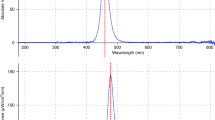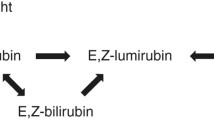Abstract
To decrease the risk of bilirubin encephalopathy and minimize the need for exchange transfusions, we report a novel design for light source of light-emitting diode (LED)-based neonatal jaundice therapeutic device (NJTD). The bilirubin absorption spectrum in vivo was regarded as target. Based on spectral constructing theory, we used commercially available LEDs with different peak wavelengths and full width at half maximum as matching light sources. Simple genetic algorithm was first proposed as the spectral matching method. The required LEDs number at each peak wavelength was calculated, and then, the commercial light source sample model of the device was fabricated to confirm the spectral matching technology. In addition, the corresponding spectrum was measured and the effect was analyzed finally. The results showed that fitted spectrum was very similar to the target spectrum with 98.86 % matching degree, and the actual device model has a spectrum close to the target with 96.02 % matching degree. With higher fitting degree and efficiency, this matching algorithm is very suitable for light source matching technology of LED-based spectral distribution, and bilirubin absorption spectrum in vivo will be auspicious candidate for the target spectrum of new LED-based NJTD light source.













Similar content being viewed by others
References
R.J. Cremer, P.W. Perryman, D.H. Richards, The Lancet 271, 1094–1097 (1958)
L. Thorington, L. Cunningham, J. Parascandola, Illum. Eng. 66, 240–250 (1971)
J. Elizabeth, Australian Paediatric Journal 11, 49–52 (1974)
A.F. Mcdonagh, Biochemical Society Transactions 4, 219–222 (1976)
J.F. Ennever, M. Sobel, A.F. Mcdonagh, W.T. Speck, Pediatric Research 18, 667–670 (1984)
K.L. Tan, G.C. Lim, K.W. Boey, Acta Paediatr. 81, 870–874 (1992)
L.A. Stokowski, Adv. Neonatal. Care 11, S10–S21 (2011)
R. Pratesi, L. Ronchi, G. Cecchi, G. Sbrana, M.G. Migliorini, C. Vecchi, G. Donzelli, Photochem. Photobiol. 40, 77–83 (1984)
American Academy of Pediatrics Clinical Practice Guideline Subcommittee on Hyperbilirubinemia, Pediatrics 114, 297–316 (2004)
M.J. Maisels, A.F. McDonagh, N. Engl. J. Med 358, 920–928 (2008)
V. K. Bhutani and the Committee on Fetus and Newborn Pediatrics, Pediatrics 128, e1046–e1052 (2011)
F. Ebbesen, P. Madsen, S. Støvring, H. Hundborg, G. Agati, Acta Paediatr. 96, 837–841 (2007)
D. Geido, H. Failache, F. Simini, J. Phys: Conf. Ser. 90, 012024 (2007)
Y. Kale, O. Aydemir, Ü. Celik, S. Kavurt, S. Isikoglu, A.Y. Bas, N. Demirel, Early Human Dev. 89, 957–960 (2013)
I. Fryc, S.W. Brown, G.P. Eppeldauer, Opt. Eng. 44(11), 111309 (2005)
I. Fryc, S.W. Brown, Y. Ohno, Proc. SPIE 5941, 59411I (2005)
J.H. Holland, Adaptation in Natural and Artificial Systems (University of Michigan, USA, 1975)
O. Surmeli-Onay, A. Korkmaz, S. Yigit, M. Yurdakok, Pediatr. Dermatol. 30, 529–533 (2013)
E.F. Schubert, Light-Emitting Diodes, 2nd edn. (Cambridge Univ. Press, Cambridge, 2006)
A.A. Lamola, V.K. Bhutani, R.J. Wong, D.K. Stevenson, A.F. McDonagh, Pediatr. Res. 74, 54–60 (2013)
T. Kolbe, A. Knauer, H. Wenzel, S. Einfeldt, V. Kueller, P. Vogt, M. Weyers, M. Kneissl, Phys. Status Solidi C 6, S889–S892 (2009)
Acknowledgments
Prof. Angelo A. Lamola is thanked for valuable advice, the graphic of action spectrum of bilirubin in vivo and corresponding data. The authors are also grateful to the support by the Key Project of Science and Technology Plan of Fujian Province of China under Grant 2013I0004.
Author information
Authors and Affiliations
Corresponding author
Rights and permissions
About this article
Cite this article
Gan, R., Guo, Z. & Lin, J. Spectral matching research for light-emitting diode-based neonatal jaundice therapeutic device light source. Appl. Phys. B 120, 645–651 (2015). https://doi.org/10.1007/s00340-015-6177-y
Received:
Accepted:
Published:
Issue Date:
DOI: https://doi.org/10.1007/s00340-015-6177-y




